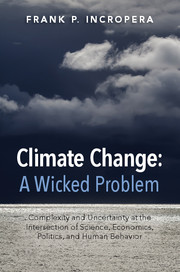 Climate Change: A Wicked Problem
Climate Change: A Wicked Problem Published online by Cambridge University Press: 05 October 2015
Environmental effects can be differentiated in terms of time scales – also called time constants. Pursuant to an input that alters the equilibrium of a system, a time scale provides an approximate measure of how long it takes for the input to achieve a significant portion (e.g., 67%) of its final effect and hence to reach a new equilibrium. The larger the time scale, the larger the inertia of the system.
Consider the infamous fogs that plagued London from the mid-1700s to the mid-1900s. They were not a natural phenomenon, but were anthropogenic and caused by the use of coal for everything from space heating in homes and businesses to, in the twentieth century, generation of electric power. During cold and still winter days, the soot and sulfur-laden gases produced by burning coal would hover over the city, reducing visibility to near zero and inducing serious illness and death among those with respiratory problems. Created by several million sources of coal combustion, the last London fog in 1952 resulted in 4,000 deaths. The problem could no longer be ignored. In 1956, Parliament passed a clean air act prohibiting coal combustion in the homes and businesses of England's largest cities, and the problem, if not eliminated, was significantly alleviated within a few years. This example illustrates an environmental problem for which the causal agents were well understood, the scope was local, there was no uncertainty concerning the nature and seriousness of the consequences, and remedies could be quickly implemented.
The ozone hole in the Earth's stratosphere provides a more recent example, one that's global in scope and for which time scales associated with remediation are much longer. Stratospheric ozone absorbs much of the ultraviolet (UV) components of solar radiation. With depletion of the ozone, more of the UV reaches the Earth's surface, with adverse effects on human health and the environment. The effects could not be ignored, and chemical reactions with the chlorofluorocarbons (CFCs) used in vapor-compression refrigeration and air-conditioning systems were determined to be the culprit.
Recognition of the problem spurred global cooperation in obtaining a solution, highlighted in 1987 by the Montreal Protocol, which committed the world's industrial nations to 50% and 85% reductions in CFC production by 2005 and 2007, respectively.
To save this book to your Kindle, first ensure [email protected] is added to your Approved Personal Document E-mail List under your Personal Document Settings on the Manage Your Content and Devices page of your Amazon account. Then enter the ‘name’ part of your Kindle email address below. Find out more about saving to your Kindle.
Note you can select to save to either the @free.kindle.com or @kindle.com variations. ‘@free.kindle.com’ emails are free but can only be saved to your device when it is connected to wi-fi. ‘@kindle.com’ emails can be delivered even when you are not connected to wi-fi, but note that service fees apply.
Find out more about the Kindle Personal Document Service.
To save content items to your account, please confirm that you agree to abide by our usage policies. If this is the first time you use this feature, you will be asked to authorise Cambridge Core to connect with your account. Find out more about saving content to Dropbox.
To save content items to your account, please confirm that you agree to abide by our usage policies. If this is the first time you use this feature, you will be asked to authorise Cambridge Core to connect with your account. Find out more about saving content to Google Drive.